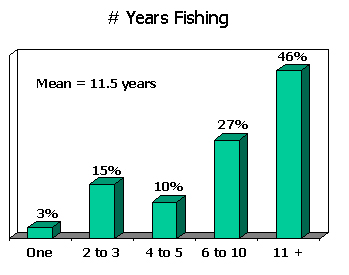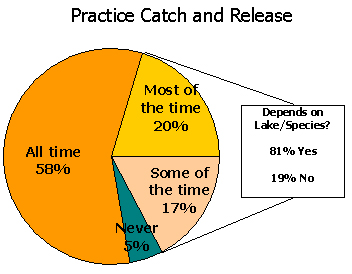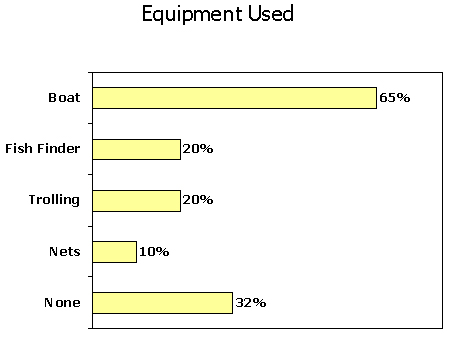|
|
||||||||||
|
|
|
|
|
|
||||||
|
|
||||||||||

SUBJECTS
Ingraham Trail Lakes Fisher Opinion Survey


Presented to
Fisheries and Oceans Canada
(DFO)
March 2005
DataPath Systems
Box 2180
Marsh Lake, Yukon, Y0B 1Y2
867.660-4600
[ Adobe Acrobat (PDF) ]
Table of ContentS
1.0 Background
In March of 2005, the Department of Fisheries and Oceans contracted DataPath Systems to complete a market research project on attitudes surrounding the fishing conditions in the Ingraham Trail Lakes, near Yellowknife, NWT.
A very important factor on this report is that this is QUALITATIVE in nature. Only 40 surveys were completed, generating a margin of error of over +/- 15%, well above the recommended range. While graphics have been created based on the findings, they are only for the demonstration of the data, and not to be taken at their literal value.
1.1 Methodology
A random list of phone numbers in the Yellowknife area was generated. Telephone calls were made by experienced First Nations interviewers between March 20 and March 28. Respondents had to meet two qualifying criteria: they had to have lived in the NWT for 3 years or more and they had to fish on the lakes along the Ingraham Trail for an average of at least once a year in the past 3 years. A total of 40 surveys were completed with qualified respondents.
In addition, another 14 people who had fished there in the past ten years, but not in the past three years were asked to comment on why they had stopped.
1.2 Main Findings
Fishing levels are fairly high, with averaging 10 fishing trips per year to Ingraham Trails Lakes.
Northern Pike and Lake Trout are typically caught, although more Pike (3.6 per trip) are taken than Trout (1.7 per trip).
Over half practice catch and release all of the time – for the remainder, most determine this based on the species they catch.
The respondents are split on the level of activity and population changes. Approximately half feel activity levels and populations are consistent since they started fishing there.
Over half are still concerned over fish populations – especially among the Lake Trout. (Some expressed concern over the increase in Jackfish at the expense of the Trout.)
The primary causes for concern was with poor fishing practices and the increased population in Yellowknife.
[ table of content ]
2.0 Incidence
Among those contacted, 62% did not fish. Among the 38% who did fish, most did live in the NWT for three years and fished in the Ingraham Trail Lakes.
- In total, 25% of the population qualified for the survey.

The following table shows 161 households completed question 1 (whether or not anyone in the household fished). Of those, 99 had no fishers and 62 did (39%).
Among those 62 households, 54 had lived in the NWT for three or more years.
Among those 54 households, 40 had also fished in the Ingraham Trails Lakes in the past three years.
Resulting in a total of 25% of the participating sample qualifying for the survey. (Lived in NWT for 3+ years and fished in the Ingraham Trail Lakes in the past 3 years.)
| Count | % of total | |
|---|---|---|
| Total households contacted: | 161 | 100% |
| No One in HH fishes | 99 | 61% |
|
Total Fishing HH |
62 | 39% |
| Have not lived in NWT for 3 years | 8 | 5% |
| Total fished and lived in NWT 3 yrs | 54 | 34% |
| Have not fished in past 3 yrs | 14 | 9% |
| Total lived in NWT 3 + yrs & fished | ||
| Ingraham Trails Lakes in last 3 yrs | 40 | 25% |
[ table of content ]
3.0 Fishing Behaviour
3.1 Frequency
For the most part, these fishers have been fishing six or more years along the Ingraham Trail Lakes.
- On average, these respondents started fishing in these lakes 11 years ago.

Most also tended to use these lakes at least six times per year.
- The average usage rate was 10 visits per year.

The lake most often mentioned for fishing was Prosperous Lake. Over half mentioned this lake as one they fish at the most.
This is followed by Prelude Lake. The other lakes follow - Other misc. lakes, Pontoon, Reid, Hidden and Madeline.

3.2 Fish Species
Northern Pike and Trout are caught in the majority of visits.
- Lake Whitefish, Walleye, Arctic Grayling are caught less frequently.

Pike are caught more often than the other fish, at nearly twice the rate.
- On a typical visit, between 3 and 4 Pike are caught, compared to between 1 – 2 for Trout, Whitefish and Walleye.

3.3 Practices
Over half of these respondents report practicing catch and release all of the time.
- Among those who only practice it some or most of the time, the majority feel that it depends on the lake or species they are fishing.
- Few report not ever practicing catch and release.

Most fishers are using boats.
- Less than one-quarter report using other fishing equipment such as fish finders, trolling or nets.

[ table of content ]
4.0 Changes Over Time
About half of the respondents felt that the level of fishing activity on the Ingraham Trail Lakes has remained about the same ever since they began fishing there.
- Among those experiencing a change, the majority felt there has been Some Increase in activity.

Over half also felt that the level of fish populations had not changed since they began fishing there.
- Among those who did feel a change has occurred, the majority felt that populations had either Decreased Somewhat or Decreased Significantly.
- The largest changes were reported in Prelude Lake and Prosperous Lake.
- Among those reporting changes, all fish species were felt to be in decline, with the exception of Northern Pike.

[ table of content ]
5.0 Concerns
Slightly over half of the respondents were concerned about the status of fish populations in the Ingraham Trail Lakes.
The greatest level of concern is over the population of trout. All respondents were concerned over the trout population.
- Fewer reported concerns for the populations of other species.

Over half rated the poor handling of fish including the use of barbed hooks, and the population of Yellowknife increasing the number of people using the lakes as having a high impact on the fish populations.

[ table of content ]
6.0 Comments
6.1 Reasons for not fishing there
The primary reason why some respondents stopped fishing at those lakes was personal reasons, such as not having time, or having children. Only one respondent reported that they stopped fishing there due to their perception of sport fisherman usage "Because they are hard to catch there, only fish I can catch are Jackfish, have heard stocks are down. Like to see the subsistence fishing put on hold for a few years, also the number of fish sport fishers can take."
6.2 Catch and Release Comments
There were two main reasons for practicing catch and release some of the time (vs. all of the time). The first was due to limits on the number of fish and the size. The second was a preference for Trout and not Jackfish.
"do not like to keep anything but trout",
"if it is jackfish I will release it".
6.3 Impacts on the Lakes
The majority of comments on what is impacting the lake centered on motorboats and increased usage. Many comments also suggested a concern with the use of the lakes and fishing behaviour and a desire for greater enforcement of the rules.
"letting people net during spawning run, educate people, more conservation"
"no limit for native people, most of the population"
"the caribou carcasses in Tibit"
"people use walkie talkies to talk to each other and slay fish, there should be more fish cops, too many people get away with breaking laws, conservation should be enforced"
"lack of monitoring, no enforcement of limits"
6.4 Fish Stocking
There was also a concern that the Jackfish are impacting the other fish and a desire for fish stocking.
"they need to stock the right fish, jackfish are eating smaller fish"
"stock more trout, jackfish taking over
"stock and put a slot and size limit on"
"restock the lakes, maybe close down some"
"thin out jackfish, fish farm might be good idea for lake trout, maybe at river lake"
6.5 Other Comments
Other comments included suggestions on conservation, management, catch and release.
"more fish cops, higher license fees, public ed on fish handling tec's, police handling of the lakes, educate people. need more conservation officers. Yellowknifer( newspaper) should change its approach to "conservation" from "killing" they take pictures of dead fish in awkward positions, solution is not in stocking lakes it is more conservation officers"
"more policing"
"think the catch & release policy should be revised, it is not a good practice of conservation, fish caught should be taken and anglers who catch their limit would then be forced to quit after their limit, not hurting fish all day"
"people leaving stuff from caribou hunts (gut piles) along the lake. May have impact on size of the fish - or maybe polluting water or causing bacteria... or whatever..."
"Hope that any changes that are made to regulations are based on science not on surveys"
"do not use calcium on roads,"
"think the fish put real restrictive limits and I do support catch & release, subsistence fishers put a great impact on on migrating and spawning fish. Open up access roads to more lakes as this would take pressure off the accessible lakes"
"think the Gov is trying its best to minimize decline."
"read the article in the paper. Reduce the number of fish aboriginals can take, do not drop the quota, too many fish will eat on each other so this will drop stocks"
"Ban 2 stroke motors, hydro dam needs to monitor carbine hydro carbon separators and sensors as machinery will break, need to study fish more, too much run off from winter roads and salt on highways, we witnessed 1900 caribou slaughtered on Bluefish Lake had to plow guts off road and they put carcasses in the lakes."
[ top of page ]